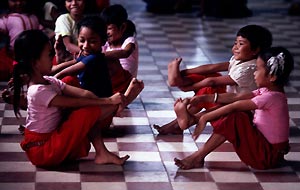Dancing Through Death
Thavro’s dedication to Cambodian Classical dance and to his role as the magical white monkey kept him whole during the ordeal. Controversy in Cambodia over whether to try Khmer Rouge leaders heightens interest in “Dancing Through Death.”
A resident of the United States since 1993, Thavro returned to Cambodia in 1998 for a bittersweet reunion with his family and teachers. The film follows him on that journey.
The centuries-old traditional Cambodian dances tell mystical stories of good and evil, with bejeweled princes, princesses, giants and monkeys as the principal figures. Cambodian dancers had a sacred role. The documentary looks at this cultural history and the ancient empire of Angkor when the Khmer ruled most of Southeast Asia.
It takes its audience to 1975-1979 and conveys the preciousness of the dancers who survived the country’s maelstrom. It tells of the transmission of a culture from generation to generation, mourning for what was lost and celebrating the dance that has survived in the midst of death, displacement, and war.
The secondary theme of the documentary is the dancers’ mission to preserve their legacy by teaching Khmer dance to children of Cambodian refugees. Personifying the younger generation is Samnang Hor, a 13-year-old monkey dancer with the Angkor Dance Troupe in Lowell, MA, where Thavro was a guest performer. Other young dancers struggle to learn the ancient art in San Jose, CA, where Thavro taught in the 1980’s. The documentary follows Thavro to New Haven, CT, where he joins the Cambodian Genocide Project to document the story of the Khmer Rouge and to search for his own relatives.
- Marlene Sanders — Executive Producer and Narrator
- Janet Gardner — Producer/Director/Writer
- Kevin Cloutier — Director of Photography
- Dina Potocki — Editor
- Richard Fiocca — Music and Sound Design
- Pham Quoc Thai — Associate Producer
- Sophy Theam — Assistant Producer
- Ruth Page — Field Producer/Lowell
Consultants:
- Dr. Toni Shapiro, Cambodian Genocide Program,
Yale Center for International and Area Studies - Dr. David Chandler, Department of History,
Monash University - Dr. Sam-Ang Sam, Faculty of Music,
Royal university of Fine Arts, Phnom Penh - Dr. George Morren, Department of Human Ecology,
Rutgers University - William Rieser,
Fund for Reconciliation and Development
Special thanks to The Fund for Investigative Journalism and Mr. John Hyde
- Broadcast 1999-2000 on PBS stations
- Satellite Television Asian Region (STARTV)
- Screened at Asia Society
- American Anthropological Association Annual Meeting
- Asian Studies Association Annual Meeting
- The Newseum, New York
- Boston’s Asian American Film Festival, 1999
Photo Gallery
Letter from a Cambodian Royal
Quotes
Reviews
The Boston Globe, May 26, 2000
By Karen Campbell
Globe Correspondent
"If you know the culture, you know the heart of a country." So believes Proeung Chhieng, dean of the School of Dance at Cambodia's University of Fine Arts, and perhaps nowhere is that claim more evident than in Cambodia, where music and dance is the countries lifeblood.
The powerful and poignant new documentary "Dancing Through Death: The Monkey, Magic and Madness of Cambodia," explores how Cambodians in the United States and in their native land are attempting to rebuild their culture after the Pol Pot regime and the Khmer Rouge turned Cambodia into "killing fields" that wiped out nearly a quarter of the country's population, including 80-90 percent of its dancers and musicians.
When the communist guerrillas of the Khmer Rouge took over the Southeast Asian Country from 1975-1979, they abolished religion, education, and culture in an attempt to wipe out any vestiges of the pervious monarchy. In effect, they turned the country in one vast slave labor camp, torturing overworking, starving, and executing nearly two million people.
Because the country's cultural tradition was largely oral, the death of master dancers, musicians, and teachers meant the loss of priceless traditions. However, as presented in Janet Gardner's compelling documentary, Cambodians are fiercely and proudly determined to restore their cultural identity. The film chronicles some of the more inspiring efforts, including those of the Angkor Dance Troupe in Lowell, where an estimated 30,000 Cambodians have settled, making Lowell the second-largest Cambodian community in the United States, behind only San Diego. The film is a tribute to survival and rebirth.
 The film follows three generations of dancers dedicated to the acrobatic role of the monkey, the only male role in Cambodian dance. For Thavro Phim, dancing the role has helped him deal with the loss of his family during the Pol Pot regime, enabling him to connect with his personal history and the cultural traditions of his country. For 13-year-old Cambodian-American Samnang Hor, one of the Angkor Dance Troupe's rising starts, the dance is a way to embody and share a past he is just now coming to understand. For the few dancers who survived during the Khmer Rouge, by either keeping their identity a secret, or using the monkey's charming blend of magic and mischief to appeal to their captors, reviving the tradition is a testament of freedom.
The film follows three generations of dancers dedicated to the acrobatic role of the monkey, the only male role in Cambodian dance. For Thavro Phim, dancing the role has helped him deal with the loss of his family during the Pol Pot regime, enabling him to connect with his personal history and the cultural traditions of his country. For 13-year-old Cambodian-American Samnang Hor, one of the Angkor Dance Troupe's rising starts, the dance is a way to embody and share a past he is just now coming to understand. For the few dancers who survived during the Khmer Rouge, by either keeping their identity a secret, or using the monkey's charming blend of magic and mischief to appeal to their captors, reviving the tradition is a testament of freedom.
The film juxtaposes touching interviews with disturbing news footage from the 1970s, archival material, and current documentation of the cultural activity flourishing today. It manages to engage, at one turn horrifying, at another uplifting.
The most memorable stories are those attesting to artistic dedication, despite all odds. Master teacher Pen Sok Huaon, enslaved by the Khmer Rouge, recalls: "Every time they send me to chop up dirt, I would stop working in order to bend and flex my arms because I have the feeling I would return home. AT nighttime, when I was free from work, I usually sang in secret each song that accompanied the dancers o I would be able to remember them."
In the refugee camps, amidst the daily struggles for survival against inhumane conditions and starvation, music and dance were a priority. Those with the least bit of basic knowledge would teach their skills to the others in order to keep the culture alive. In turn, the culture keeps them alive. As Toni Shapiro-Phim of Yale's Cambodia Genocide Program puts it, "For those few hours a day, they were beautiful and in control."
DANCING THROUGH DEATH: THE MONKEY, MAGIC AND MADNESS OF CAMBODIA
Produced and directed by: Janey Gardner
On: WGBX-TV (Ch. 44)
Time: Sunday, 10-11 p.m.
L.A. Times, February 15, 2000
Home News Tribune
Princeton Packet Online, November 3, 1999
Awards
- Winner of the CINE Golden Eagle Award, 1999
Distributor
347 West 36th Street, Suite 1200
New York, NY 10018
USA
Purchase and Streaming Options
- For personal DVD purchase, please contact The Gardner Documentary Group.

